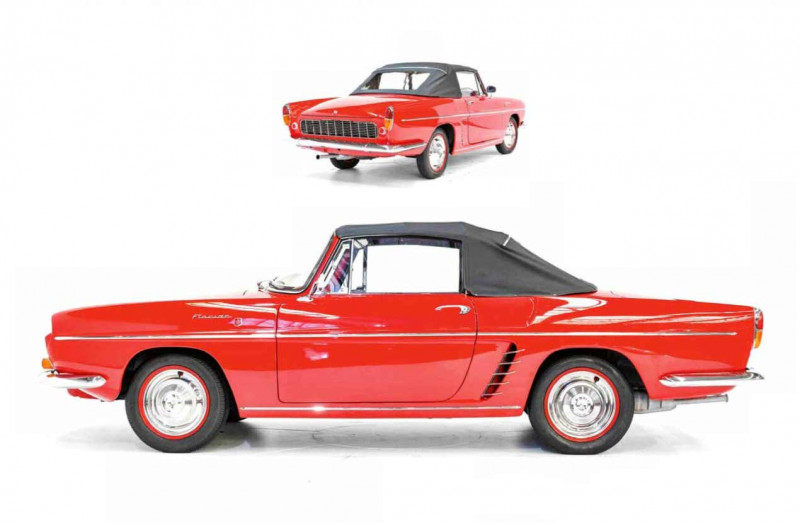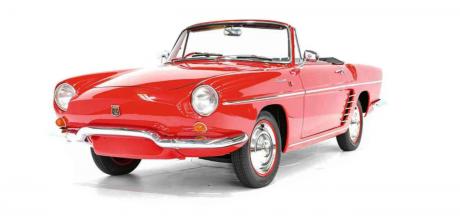1958 Renault Floride - shifting France into Ghia
Renault turned to Italy in the quest to create an image-builder
America has been responsible for some truly cool cars. That includes cool European cars. America’s post-war riches prompted cars from the Mercedes-Benz 300SL W198 to the Volkswagen Karmann Ghia – and a French imitatrice, the Renault Floride.
Pierre Dreyfus presided over Renault from 1955 to 1975. He replaced Pierre Lefaucheux, killed when his briefcase struck him in the neck as his Renault Fregate slid off the road on black ice. Lefaucheux had overseen development of the rear-engined Dauphine sedan, a hit on its launch in 1956.
That year, Dreyfus and director of research Fernand Picard travelled to the US to meet with Renault’s US dealers. The recurring theme was for an affordable, sporty model to appeal to young buyers and drive image for the Dauphine – as the Italian-designed Karmann-Ghia was doing for Volkswagen. At a dinner party in Florida, the Renault men hatched Project R1092 (the Dauphine was R109). The car would later be named Floride, or Caravelle in the US, fearing interstate resistance.

Renault turned to Ghia, who had helped with the Dauphine. Ghia’s US pal, Chrysler designer Virgil Exner, recommended his son, Virgil Exner Jr. From his US Air Force barracks, Junior submitted his initial design proposals, subsequently approved by Renault.
Controversy erupted with the building of the first prototypes by Pietro Frua, Ghia styling chief in 1957. Frua is now widely credited with the R1092 design – though there is no doubt that he penned the second generation (R1133) in 1962.
At the Floride’s 1958 Paris unveiling, more than 8000 orders were taken, with another 13,000 soon added from its New York reveal. Having Brigitte Bardot as the car’s ambassador may not have hurt.
The Floride/Caravelle was available as either a coupe, convertible with hardtop, or ragtop convertible. Production of bodies was subcontracted to bus-builder Chausson and final assembly to Brissonneau et Lotz, maker of Paris’s Metro locomotive carriages.
Beneath the Floride’s Franco-American style, performance from the 845cc Dauphine donk was lacklustre and the swingaxle handling entertainingly iffy, despite early augmenting with ‘Aerostable’ pneumatic cushions.
The R1133-series Caravelle of 1962 looked like a facelift, but was developed over Renault’s new R8 sedan platform and 956cc (later 1108cc) ‘Sierra’ drivetrain. The Floride name was dropped.
Production ended in July 1968, after a total of 117,113 Florides and Caravelles were produced. VW’s Karmann Ghia, meanwhile, racked up more than 444,000 units over 22 years – and the Beetle didn’t do too badly, either.
DAUPHINE DONKS
The Dauphine’s 845cc four-cylinder ‘Ventoux’ engine dated from the 4CV of 1947, and for the Floride made 26kW. A factory Gordini option added 4kW. The three-speed manual was joined by a four-speed in 1960. Things stepped up in 1962 with the R8-sourced 956cc ‘Sierra’ engine (38kW), enlarged in 1964 to 1108cc (41kW). Our red car is a rare 1962 ‘R1092 S’, R8-engined when the factory ran out of Dauphine donks.
PARTS-BIN PRINCESS
The Floride came in a trio of roofing options – a bolted-on coupe, clip-on hardtop convertible, or pure ragtop – but weights were respectable, at 772kg (823kg for the second-gen). All offered ‘occasional’ rear seating with a fold-down plank, better left folded to augment the generous front boot space. Dauphine parts-bin still brought gorgeous details, like the crest designed by jewellers Van Cleef & Arpels.

IN DETAIL
- 1960 Floride launched in Australia
- 34,226 Production of R1133 (R8-based) models
- 4 panels to make a front guard, with hand-filled seams
- 1962 Caravelle (R1133) is first French production car with four-wheel discs


